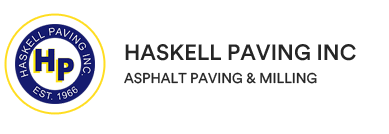The Pitch
Asphalt is a thick, black ‘sticky’ liquid, commonly known as bitumen, macadam, blacktop, pavement, and pitch. It is the material of choice by construction professionals when creating roadways, playgrounds, and parking lots because of its strength and durability, resulting from its composition of asphalt cement, stone, sand, and gravel.
The Parking Lot
Asphalt paving is an excellent eco-friendly material to use for parking lots, due to its ability to be removed, recycled, and used for ingredients to help create new asphalt in the future. Any 'noise pollution' of the roaring cars and trucks is quickly absorbed by the asphalt, especially when recycled rubber tires are part of the mix. Due to the aggregate mix of stone, sand, and gravel found in asphalt paving, there is a skidding resistance.
In NJ, the paving process starts with obtaining necessary permits from the municipality of your business location. The next required step is a call to NJ One Call (call before digging) to assess a mark-out of any utility lines underground. Next, existing asphalt is removed down to the sub-grade, and the sub-grade evaluated for any signs of compromise to proper water drainage. The sub-grade may require the removal and replacement of a recycled aggregate mix of sand, gravel, and stone. This aggregate mix is essential to obtain a solid base for parking.
All asphalt paving material must meet the NJ Department of Transportation standards for the type of commercial parking lot it will become. The asphalt is then compressed with heavy equipment rollers, with the final step the all-important painting of directional arrows, traffic lanes, pavement instruction, as well as the lines indicating parking spaces.
To ensure you’re not missing any steps, a commercial paving company, such as Haskell Paving, could assist you with all of the above.
Here Are The Dos And Don’ts After An Asphalt Paving Job
To maintain those great first impressions with customers and sustain those investment dollars, we present a few simple dos and don’ts after the paving project has been completed:
DO install curbing around landscaped areas to prevent soil or seed washout to the pavement. Soil and seed can seep into the porous asphalt and cause cracking.
DO semi-annual preventative maintenance. Preventative maintenance includes the cleaning of the material with vacuum sweeper trucks twice a year. At times, a low-pressure water cleaning, followed by vacuum sweeper, will be needed if the surface has become clogged by oil, grease, and soil.
DO NOT use a broom sweeper due to the high volume air-blast that is part of the cleaning of the surface and brings peeling of the surface and debris to be sucked into the unit.
DO NOT drive on the pavement for at least 24-hours, longer in hot weather, to allow the material to cure and harden.
DO sealcoat your asphalt parking lot one year after installation and every two years after that.
DO NOT USE SAND or ABRASIVE MATERIALS in winter as it can clog the porous nature of the material and cause cracking and potholes. Standard road salt is the best de-icing material on asphalt paving.
Let the well-seasoned experts at Haskell Paving walk you through it. To ensure you’re protecting your investment, we can help with your commercial asphalt installation and the best maintenance practices to keep your lot safe. Contact us today for a quote!

